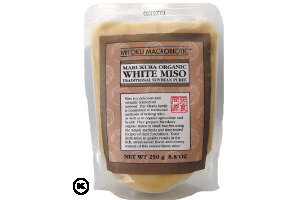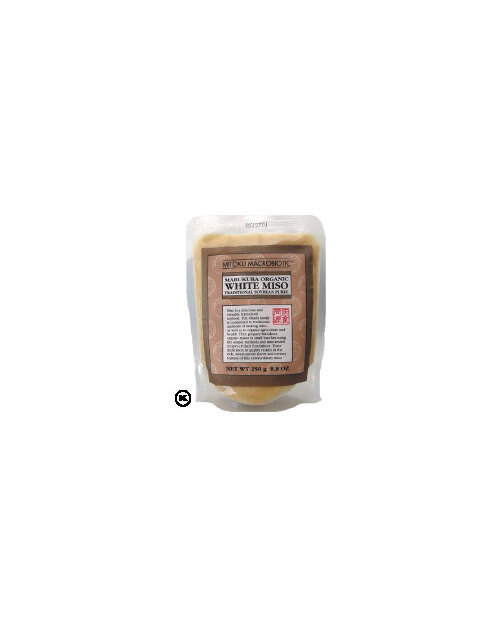The Okada family is committed to traditional methods of making miso, using the simple recipe of their forefathers. Their dedication to quality results in an extraordinary line of miso and koji. The light, sweet taste and smooth texture of Marukura Organic Sweet White Miso makes delightfully creamy sauces, dips and salad dressings, as it is delicately refreshing.
Ingredients: Organic hand-made rice koji, organic whole soybeans, water, and sea salt.
Origin: Japan
"Dairy Free Pasta & Miso 'Cheese' Sauce Recipe below(Scroll down)
Cooking with Miso
From sweet, creamy, and light to hearty, robust, and dark, Mitoku has an exciting variety of misos available to add to your cooking and dining enjoyment. As you will see, miso can be used to enhance everything from basic macrobiotic dishes to gourmet fare.
The key to fine miso cookery is not to overpower dishes with a strong miso taste, but to integrate the more subtle aspects of miso color and flavor in a gentle balance with other ingredients. For example, when making miso soup, the use of a kombu, shiitake, kombu-bonito, or vegetable stock helps achieve a full, rich flavor with considerably less miso than you would need if you boil vegetables in plain water and rely on miso to supply all the flavor. The latter method usually results in either an overly salty soup or one that is watery, bland and unappetizing. With respect to color, bright summer vegetables such as sweet corn or yellow squash and lightly cooked greens floating in the beautiful yellow to beige colored broth of light, sweet miso soup is appealing in warm weather, whereas the earthy tones and hearty flavor of dark miso soup with chunky root vegetables and wakame or kale is pleasing during the colder months.
Certain general rules can be applied when cooking with light, sweet misos, such as opposed to dark, salty ones. The light color, sweet taste, and creamy texture of sweet miso is suggestive of its application in Western-style cooking: it is an excellent dairy substitute. For example, try a little sweet miso instead of milk, butter, and salt in creamed soups, and with tofu and lemon or rice vinegar in place of sour cream for dips and spreads.
To realize the full potential of sweet miso, explore its uses in salad dressings and sauces. Sweet miso and naturally brewed rice vinegar create a delicious tartness that is both refreshing and cooling. Known as su miso, this combination has a long history in Japanese cuisine. Blended with your choice of other ingredients such as oil, onion, dill or other herbs, rice syrup, tofu and tahini, sweet miso and rice vinegar complement each other perfectly in American style dressings, dips and sauces.
In contrast, dark, saltier misos combine nicely with beans, gravies, baked dishes, and vegetable stews and soups. For a simple and delicious fall or winter vegetable dish, try adding sweet chunky vegetables such as winter squash, carrots, or parsnips to sautéed onions, steaming them in 1/4 inch of water until just tender, then seasoning with dark, long-aged rice or barley miso thinned in a little water or stock just before the end of cooking. Try dark miso in thick soups using root vegetables such as burdock, carrots, and daikon. A lentil casserole seasoned with dark miso warms the body and supplies plenty of high quality protein. Although dark misos are not as versatile as light varieties, traditionally made, unpasteurized dark miso makes nutritious, flavorful and satisfying miso soups that you can enjoy every day in fall, winter and spring without ever becoming tired of them. Once the weather becomes warm, we prefer to combine a dark and a light miso when making miso soup.
Mixed with sweet, tangy, or pungent ingredients such as mirin, rice syrup, rice vinegar or fresh ginger, dark miso can be used in refreshing sauces. Remember that dark miso is stronger in taste than sweet miso, so use it sparingly.
Both dark and light misos are suitable for certain special uses. In general, miso is a good choice when you are looking for a salting agent, digestive aid, or tenderizer. As a salting agent, miso supplies much more in terms of flavor and nutrition than plain salt without salt's harshness. When substituting miso for salt, add approximately one level tablespoon of any sweet, light miso or two level teaspoons of dark, salty miso for one-quarter teaspoon salt.
Dairy Free "Macaroni and Cheese
Serves 4
This dairy-free version is nonetheless rich and satisfying. Vegetables can be added for a type of Pasta Primevara, but be careful not to overcook them. They should be tender-crisp.
Sauce:
1 1/2 tablespoons organic olive oil
2 cloves garlic, finely minced
1 small onion, diced
3 tablespoons organic white flour(or gluten free flour to thicken, buckwheat, quinoa, etc.)
1 1/2 cups vegetable stock or water
pinch Himalayan Salt
pinch white or black pepper (optional)
2 tablespoons Mitoku Marukura Sweet White Miso
2 tablespoons organic tahini
2 tablespoons finely chopped fresh basil/herbs
1/4 cup parsley, minced
1 tablespoon red wine vinegar or lemon juice
200g macaroni (gluten free varieties or try edamame & mung bean fettucine or other bean pastas)
Method:
Add the oil to a medium-sized frying pan, and sauté the garlic and onion over low heat for 2 minutes, being careful not to brown the garlic. Add the flour and stir constantly for 1 minute. Slowly add the stock, whisking until the sauce thickens somewhat. Add a pinch of salt and, if desired, pepper, and simmer 5 minutes. Add a little more stock as needed, if sauce is too thick.
In a small bowl combine the miso and tahini, and gradually mix in 1/4 cup stock or water. Add the mixture to the sauce and simmer very gently for 1 to 2 minutes. For the last minute add the basil, about 3 tablespoons of the parsley (reserve the rest to garnish), and the vinegar or lemon juice.
Add the 'pasta' of choice to 2 Litres of rapidly boiling, salted water. As soon as the 'pasta' is cooked, drain it and immediately toss it with the sauce in a large bowl. Serve with a sprinkling of parsley.







